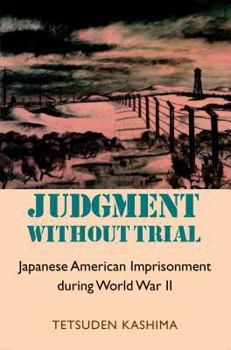Judgment Without Trial: Japanese American Imprisonment During World War II
Select Format
Select Condition 
Book Overview
2004 Washington State Book Award Finalist
Judgment without Trial reveals that long before the 1941 attack on Pearl Harbor, the U.S. government began making plans for the eventual internment and later incarceration of the Japanese American population. Tetsuden Kashima uses newly obtained records to trace this process back to the 1920s, when a nascent imprisonment organization was developed to prepare for a possible war with Japan,...
Format:Hardcover
Language:English
ISBN:0295982993
ISBN13:9780295982991
Release Date:July 2003
Publisher:University of Washington Press
Length:336 Pages
Weight:1.45 lbs.
Dimensions:1.2" x 6.0" x 9.0"
Grade Range:Postsecondary and higher
Customer Reviews
2 ratings
Sheds new light on reasons for internment
Published by Thriftbooks.com User , 20 years ago
This book is a comprehensive look at some of the major reasons for the internment of Japanese and Japanese Americans during WW2. Many people think that racial hatred of Japanese started with the bombing of Pearl Harbor in 1941, but actually this was only the culmination of years of anti Japanese feelings , especially on the west coast. Most of the first generation Japanese were farmers, and they made what was once thought to be barren wasteland into some of the most productive land in the US. However, the 1920 Land Act prohibited all Japanese nationals from owning any land, and first generation Japanese were PROHIBITED from becoming US citizens, laws influenced by racist white farmers to prevent any more Japanese from owning farm land. The ever resourceful Issei (first generation Japanese) bypassed this by putting their land in their childrens (by law, American citizens) names. In 1924, the Congress and President Coolidge passed the Anti-Asian exclusion act, which prohibited any more immigration by Japanese (and other Asians) (for an excellent reference, see Roger Daniels "The Politics of Prejudice" for an authoritative look at the laws used to discriminate against Japanese during the early 20th century). In addition, Newspaper publishers like William Randolph Hearst were making large efforts to inflame anti Japanese sentiment in their newspapers. When Pearl Harbor occured, mass hysteria ensued. Many Japanese owned businesses were burned and looted and homes of Japanese families were vandalized and attacked. It was Feb. 1942 when Executive Order 9066 effectively gave all persons of Japanese ancestry, some times as little as 72 hours, time to pack their belongings, settle their affairs, and report for "relocation" (a euphemism if there ever was one). One last fact that a previous reviewer conveniently doesn't mention- The US Army's 442nd and 100th all Nisei(second generation) combat units, comprising nearly 10,000 men, were the most decorated units for their size in the history of the United States.While their families were locked up or prevented from returning to their lawful homes, "these brave men fought prejudice and won" - spoken by Pres. Harry Truman in 1945 in a ceremony honoring the 442nd and 100th battalions.Its on archival news reels, for any doubters out there. A previous reviewer says that the WW2 internment of Japanese Americans was NOT due to racial hatred and prejudice- this book and a look at history and the congressional record for the aforementioned anti-Japanese legislation would prove him dead WRONG.
Diaries, contemporary sources, and official communications
Published by Thriftbooks.com User , 20 years ago
Judgment Without Trial is a college-level survey of Japanese American imprisonment during World War II and reveals that even before Pearl Harbor, the US government was making plans for the eventual internment of the Japanese American population. Newly discovered records traces this back to the 1920s and plans to prepare for a possible war with Japan. This plus new information on experiences of people of Japanese descent in the Justice and War Departments' camps for internees from Alaska, Hawaii and Latin America makes for an important, different guide which blends diaries, contemporary sources, and official communications in a revealing history.





